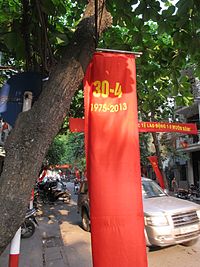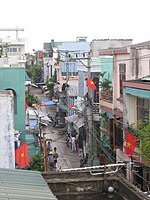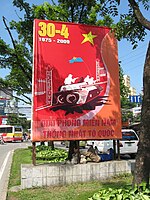Reunification Day
| Reunification Day | |
|---|---|
 Banner in Hanoi for Reunification Day, 2013 | |
| Official name | Day of liberating the South for national reunification (Giải phóng miền Nam, thống nhất đất nước) |
| Also called | Reunification Day (Ngày Thống nhất) Liberation Day (Ngày Giải phóng) Victory Day (Ngày Chiến thắng)[1] Black April (Tháng tư đen) Fall of Saigon (Sài Gòn thất thủ) |
| Observed by | Vietnamese |
| Type | National |
| Significance | Marks the Fall of Saigon |
| Date | 30 April |
| Next time | 30 April 2025 |
| Frequency | Annual |
| Related to | Fall of Saigon |
Reunification Day (Vietnamese: Ngày Thống nhất), also known as Victory Day (Ngày Chiến thắng), Liberation Day (Ngày Giải phóng or Ngày Giải phóng miền Nam), or by its official name, Day of the Liberation of the South and National Reunification (Ngày Giải phóng miền Nam, thống nhất đất nước)[2] is a public holiday in Vietnam that marks the event when the North Vietnamese and Viet Cong forces captured Saigon (now Ho Chi Minh City), the capital of South Vietnam, on 30 April 1975, thus ending the Vietnam War. The event marked the start of the transition period of reunification, which also occurred after a vote in the National Assembly[3] for reunification on 2 July 1976, when South Vietnam and North Vietnam were merged, forming the modern-day Vietnam.[4]
In some of the overseas Vietnamese communities of people who fled from South Vietnam after its fall, the day is commemorated as the Fall of Saigon, Black April (Tháng tư đen),[5][6] National Day of Shame (Ngày quốc nhục) or National Day of Hate (Ngày quốc hận).[5][7] This is a commemorative day for exiled Vietnamese who served, were affected, and displaced in those overseas communities, and as such is a day of reflection.
Gallery
[edit]-
Statue commemorating the "Victory of 30 April 1975" at the Museum of the Ho Chi Minh Campaign
-
A street in Da Nang, Vietnam. Flags are being displayed on the occasion of Reunification Day, a national holiday
-
A sign in Hanoi, 2009, depicting the moment a Viet Cong tank crashed into the Presidential Palace on April 30, 1975.
-
A large road sign in Ho Chi Minh City, Vietnam, commemorating the 30th April 1975. The pictures bears the declaration of a total victory.
See also
[edit]- 1954 division of Vietnam
- Liberation Day in other countries
- Unity Day in other countries
- Victory Day in other countries
- April 30 Park
References
[edit]- ^ "Bộ Luật lao động 2012". Thuvienphapluat.vn. Retrieved 30 April 2018.
- ^ Tin Liên Quân (1 May 2016). "Nhiều hoạt động kỷ niệm 41 năm ngày Giải phóng miền Nam, thống nhất đất nước (30/4/1975 – 30/4/2016)". Hànộimới. Retrieved 30 April 2018.
- ^ "Quốc hội quyết nghị lấy tên nước là Cộng hòa Xã hội chủ nghĩa Việt Nam". Quân đội nhân dân. Retrieved 17 August 2023.
- ^ "5. Cuộc tổng tuyển cử ngày 25 tháng 4 năm 1976 đánh dấu bước thắng lợi quyết định của nhân dân ta trên con đường thống nhất nước nhà về mặt nhà nước (Ngày 24 tháng 6 năm 1976)". Dangcongsan.vn. Retrieved 30 April 2018.
- ^ a b "Black April". UNAVSA Knowledge. Retrieved 7 December 2013.
- ^
- "Black April". Los Angeles Times. Archived from the original on 6 May 2008. Retrieved 7 December 2013.
- "Black April". VNAFMAMN. Retrieved 7 December 2013.
- Secretary of State. "Assembly Concurrent Resolution No. 220 Chapter 74 Relative to Black April Memorial Week". Legislative Counsel's Digest. California Legislative Information. Retrieved 7 December 2013.
- Kurhi, Eric (30 April 2013). "Black April ceremony honors Vietnam War soldiers in San Jose". San Jose Mercury News. Retrieved 7 December 2013.
- Bharath, Deepa (29 April 2011). "O.C. Black April events commemorate fall of Saigon". Orange County Register. Retrieved 7 December 2013.
- ^
- Bharath, Deepa (25 April 2008). "Black April events commemorate fall of Saigon". Orange County Register. Archived from the original on 18 May 2009. Retrieved 28 May 2009.
- "Audio Slideshow: Black April". Los Angeles Times. Retrieved 28 May 2009.
- Trần, Mỹ-Thuận (30 April 2009). "Orange County's Vietnamese immigrants reflect on historic moment". Los Angeles Times. Retrieved 28 May 2009.
- Dzũng, Đỗ (30 April 2009). "Tưởng niệm Tháng Tư Đen ở Quận Cam". Báo Người Việt. Archived from the original on 2 May 2009. Retrieved 28 May 2009.
Text is available under the CC BY-SA 4.0 license; additional terms may apply.
Images, videos and audio are available under their respective licenses.




